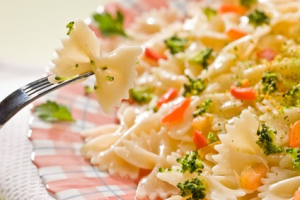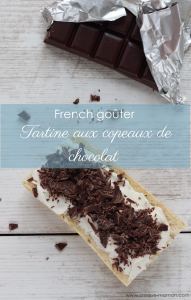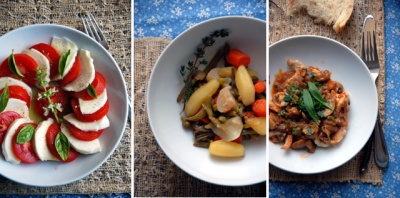 I am very excited, and honored, to be doing this guest post for Karen. Her work and crusade are so worthwhile. I am a French mom living in LA, raising a 19 months old son, and writing my FrenchFoodieBaby blog about our journey in educating his taste buds and making him a gourmet and healthy eater, the French way. And I’m here to debunk some of the myths and mystique behind French family cuisine, and try to show families that the French approach is much simpler than it seems.
I am very excited, and honored, to be doing this guest post for Karen. Her work and crusade are so worthwhile. I am a French mom living in LA, raising a 19 months old son, and writing my FrenchFoodieBaby blog about our journey in educating his taste buds and making him a gourmet and healthy eater, the French way. And I’m here to debunk some of the myths and mystique behind French family cuisine, and try to show families that the French approach is much simpler than it seems.
The French way of eating, and their approach to educating children’s taste buds, has definite benefits (including the fact that kids actually enjoy eating vegetables, and have lower rates of obesity). So the next logical step would be for more people to implement and adapt those methods for their family. And a lot of families have indeed been inspired by it, as demonstrated by the great deal of interest in Karen’s book and work in general. But I have found in my interactions with a lot of moms and families mostly in the US, that there’s this ingrained belief that French food is fancy. I say “French-style cuisine” and a lot of people visualize intricate sophisticated dishes, hours laboring by the stove, expensive ingredients… all of which would make it quite impractical to most families, and wasted on young children. (Note that I talk about “French-style” cuisine or “French way of eating”, because I’m not so much talking about what the French eat and French cuisine per se, but how the French eat, the way they approach food and nutrition. You can adopt that approach with any type of international cuisine, and in fact, a lot of French families cook from a variety of cuisines from around the world.)
I started becoming more aware of those preconceptions about French cuisine when I started my son on solids when he was about 5 months old. I was following a Mommy & Me class which happened to be around lunch time, and started bringing my homemade baby purees to class. Soon came the era of finger foods, around eight months, and I started bringing a mini-version of a “4 course meal” for Pablo in class, basically a finger food as appetizer (hearts of palm, green beans, cauliflower, etc.), a homemade protein & vegetable puree, a kind of cheese, and a bit of fruit compote or yogurt for dessert. There I was, thinking I was doing nothing out of the ordinary. And one day, another mom commented on the “gourmet meals” I was making Pablo, and that he was the “best fed baby in LA.”
This same perspective a lot of North Americans have of French cuisine, shows up again when you start telling them what French kids are served for lunch in school. When I first told my husband we were served a sit-down hot four-course lunch, he just couldn’t believe it, rethinking with some nausea about the sloppy Joes, pizzas, stale spaghetti and overcooked burgers he ate in school.
Karen’s brilliant idea to post the menus from French school lunches on her blog, really shows some concrete examples of what goes on every day in French schools, and by extension, what they eat at home too.
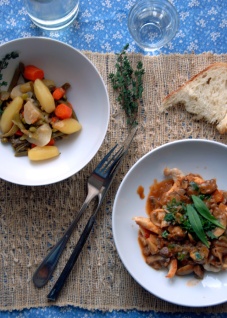
I am often asked by busy moms browsing through Pablo’s menus, “How can you do these fancy meals for Pablo every night?” Well, I hate to kill the bubble and gourmet aura around French family cuisine, but I’m here to tell you that it’s just
not that fancy.
Well… it is, and it isn’t.
If by fancy, you mean that it tastes really good, then yes it’s the idea. If by fancy, you mean some thought and finesse has been put into the dishes that compose a meal, then absolutely. If by fancy, you mean that care was put into presentation and preparation, definitely. That approach is the cornerstone of the French view of food as a pleasurable, worthwhile, sharing experience.
However…
If by “fancy”, you mean I slaved by the stove all day to prepare them, well, that’s…
Myth #1 – French style meals take hours to prepare.
Most French moms work, and are definitely back at work by the time they start their babies on solids, so they can’t spend the whole day by the stove. I found that most family dishes we cook on a weekly basis require 20-25 minutes of preparation with some additional cooking time, during which other stuff can get done.
As Karen has mentioned, studies show that the French do spend on average 13 more minutes cooking per day than Americans, cooking on average for a total of 43 minutes per day. Feeding a family a fairly balanced diet with a wide variety foods, vegetables in particular, doesn’t require a lot more time, but it does require a bit of thinking and effort. I think the French think of “the education of taste” as an important parenting and family priority. They find a way to devote it a little bit of time and effort, because eating well as a family is of value to them, the same way they would devote time to homework, or getting their kids to practice the piano.
Tip: It is mostly a matter of being a bit organized, by making a meal plan, having some cooked veggies or soup made ahead for the week, and planning on a balance of simple preparations (smoked salmon or canned sardines or a slice of ham, or pan-fried meat or fish, or crock pot recipes) to help keep busy nights stress-free. (If cooking is stress provoking, kids will pick up on it, and it will definitely put a dent on that food/pleasure association in their mind). It is also a matter of accepting to take a little extra time to do it. Trying to think of cooking not as a chore, but as an opportunity to slow down, be in the moment, and do something really good for our family.
If by fancy, you mean that French-style cooking uses hard to find, obscure ingredients for intricate dishes, that’s…
Myth #2 – French style meals are very complex and sophisticated
To the contrary, I would argue a lot of French family dishes shine by their simplicity, from chocolate mousse, with only a few ingredients, to mixed vegetable salads simply tossed together. Most French family recipes are not any more complicated (often less) than making chocolate chip cookies, muffins or pancakes.
One French secret is the way they
name their dishes. It always
sounds sophisticated. As Karen
reported recently, Cornell researcher Brian Wiansick found that using attractive names for foods do make them more appealing. And to children especially. And if you peruse the French school lunch menus, you will see many “fancy” names for very simple dishes. For example, saying “Jardinière de légumes” sounds better than “mixed vegetables”, it gives the image of a garden where the vegetables grew. The French, known to take food very seriously, wouldn’t give foods silly names to get kids to eat them (not on the official school menu anyway), but even the restaurant-like names on those menus might just make the kids feel like they’re important enough to be served “fancy” dishes.

And the dishes also often look sophisticated, as care is definitely given to presentation, for children included. The French really consider that the aesthetics of food is key to children’s education of taste and appreciation of cuisine. All five senses are involved in the pleasure of eating.
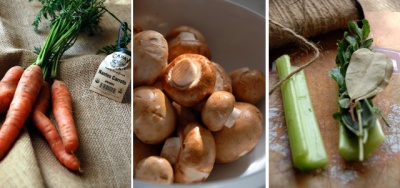 Tip
Tip: I pick a lot of fairly simple recipes that make their ingredients shine. For that, it is important to choose good quality ingredients and fresh produce as much as possible.
Another secret is the use of herbs and certain condiments to add some subtle flavor to dishes. My mother can’t cook without thyme and bay leaves. Tarragon, parsley, basil for salads. These simple herbs are the “je-ne-sais-quoi” of French cooking.
If by fancy, you mean that it costs an arm and a leg, that’s…
Myth #3 – French meals are expensive
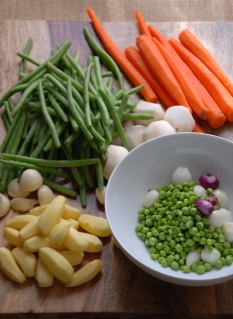
I guess that this is relative to every family’s budget, and certainly the price of food has gone up everywhere. But in our family, using seasonal produce, cooking with fresh (or frozen) foods and planning our menu has eliminated a lot of waste and saved us a lot of money. We’re not talking
truffle and lobster here, but peas, carrots and chicken.
Tip: Finding ways to cook with what we’ve got left in the fridge can lead to very creative recipes and fun meals. Also the advantage of cooking on a regular basis, is great money-saving leftovers. I’m pretty thrilled on an exhausted evening, to find we have leftover watercress soup, mustard pork tenderloin and sauteed apples and onions in the fridge…
In an attempt to illustrate my points here, I picked a lunch menu served last October in a French school in St Manvieu Norrey, Normandy, sharing the recipes with you here. It sounds really nice, but is actually very simple to make, with inexpensive ingredients, taking a reasonable amount of time to prepare (with the possibility of making some of it ahead.) And last but not least, it is really delicious, and offers a wide variety of vegetables in one meal. So why not try it?
Appetizer: Tomato mozzarella salad (not much of a recipe, just slice, drizzle with olive oil, add herbs and serve!)
Main course: Chicken cutlets with “sauce chasseur” (hunter’s sauce, cool name), with jardinière de légumes (this is a fancy name for gently sautéed vegetables)
Fromage blanc (rough equivalent here would be Greek yogurt)
Dessert: Wafer cookie (store bought)
(For a home meal, I would forgo the cookie, give a piece of cheese, and the Greek yogurt as dessert, sprinkled with a bit of sugar or a few berries.)
Chicken fillets with sauce “chasseur”
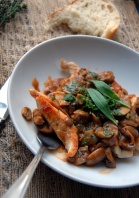
Serves 4
Prep time: 20 minutes
Cook time - 15 + 10 minutes
Age for babies: 10-12 months in small quantity, to give a taste of the sauce. The mushrooms make a good finger food.
Note that you can use this sauce with any poultry. You could also serve it with a cut up chicken, or a whole roasted chicken.
4 pieces of skinless chicken (either breast or thigh)
1 lb mushrooms, washed and sliced
6 tbsp of butter
4 shallots, peeled and minced
2 heaping tbsp flour
1/2 cup white wine (or white grape juice, or juice from canned mushrooms, if you want to go alcohol-free)
1/4 cup chicken broth
1 tbsp of tomato concentrate
1 bouquet garni (in a piece of hollow celery rib, put some thyme, parsley, sage, 1 or 2 bay leaves, cover with another piece of celery rib and tie with kitchen tie.)
Salt & pepper
5-6 sprigs of fresh chervil (if you can find it, I’ve had a hard time finding it in LA), stem removed, minced
5-6 sprigs of fresh tarragon, stem removed, minced
Cut the chicken in strips and set aside.
For the sauce:
In a saucepan, melt the butter and sauté the mushrooms. Add in the shallots, and cook for a few minutes.
Sprinkle flour, stir and let it get a bit of color.
Stir in the wine and broth. Add the tomato concentrate, bouquet garni, salt & pepper.
Stir and bring to a boil. Cover and let simmer over medium low for about 15 minutes.
At this point, you can keep warm, covered, on very low heat, while you cook the chicken.
In a frying pan, heat some olive oil over medium heat. Sauté the chicken strips until cooked. Salt & pepper to taste.
Before serving the sauce, remove the bouquet garni, and incorporate the minced chervil and tarragon.
Pour sauce over the meat and serve immediately!
Jardinière de légumes (Mixed vegetables)
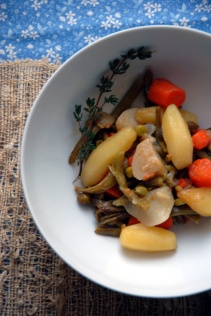
Serves 4
Prep time: 25 minutes
Cook time: 35-40 minutes
Age for babies: 8-10 months, the veggie pieces make great finger foods.
I use two magical ingredients here, which make the vegetables taste delicious and slightly sweet: the sprinkle of sugar, and the coconut oil (which is so good for you too). Kids usually love it.
You can add more vegetables or omit some, adjust quantities to your liking. This tastes really great reheated, so you can make a big batch, refrigerate and eat the next couple of days.
7-8 carrots, peeled, diced
7-8 mini turnips, peeled (or 1 or 2 medium, peeled and quartered)
15 small potatoes, peeled (fingerling type, or medium red potatoes, peeled and quartered)
2 handfuls of fresh green beans (or frozen)
2 handfuls of shelled fresh peas (or frozen)
6 pearl onions, peeled but left whole
2 garlic cloves, peeled but whole (optional)
Fresh thyme (leaves from 3 sprigs)
Bay leaf
Coconut oil
2 tbsp butter
1 tbsp sugar
Salt & pepper
In a large pot, melt the butter & coconut oil over medium heat. Sprinkle with the sugar, stir a bit, and wait until the sugar has melted.
Then add carrots, turnips, potatoes, pearl onions, garlic, thyme and green beans. Add salt and pepper, stir and cook for about five minutes over medium heat, stirring once in a while.
Add 1/4 cup of water, and cook on low, letting the water evaporate, stirring from time to time, about 20 minutes.
Add another 1/4 cup of water and the peas, and let cook until the water is almost evaporated and vegetables are tender, about 15 minutes. (There should be a little “sauce” in the bottom, a treat to soak it up with good bread!)
Bon appétit! And I’d love to hear your thoughts, if you do try these recipes and this multi-course meal!
Like this:
Like Loading...
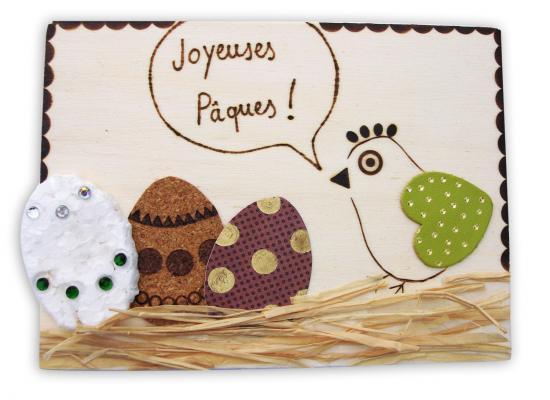
A special Easter pâté might also be served; the traditional recipe is a square loaf of pâté baked with eggs inside, wrapped in puff pastry-which has a fun look when sliced.
 Dessert is varied, but there is often a pound cake rich in eggs. The French also often make an edible ‘Easter nest’, which is simultaneously a decoration and dessert-shaped in puff pastry in the form of a nest, and stuffed with edible chocolate eggs. A hit with the kids, it goes without saying.
Dessert is varied, but there is often a pound cake rich in eggs. The French also often make an edible ‘Easter nest’, which is simultaneously a decoration and dessert-shaped in puff pastry in the form of a nest, and stuffed with edible chocolate eggs. A hit with the kids, it goes without saying.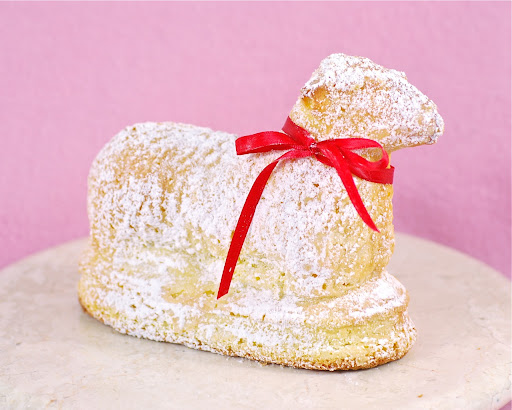 Each region will have its specialties too: the ‘lamala‘ (baby lamb) cake from Alsace, made in a special pottery cake mold only used at this time of year (it’s designed to stand up and look like a lamb, which it actually sort of does), or the ‘fouace’ bread (a sweet brioche somewhat like challah) from the south-west of France.
Each region will have its specialties too: the ‘lamala‘ (baby lamb) cake from Alsace, made in a special pottery cake mold only used at this time of year (it’s designed to stand up and look like a lamb, which it actually sort of does), or the ‘fouace’ bread (a sweet brioche somewhat like challah) from the south-west of France.
